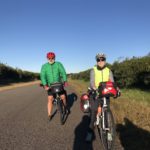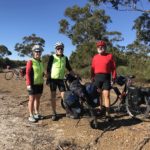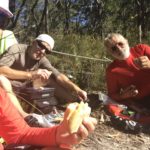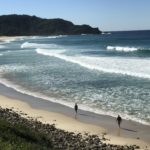Hawks Nest to Blueys Beach (63 km by bike)
We are on the traditional territory of the Worimi People
It was a cold 2oC when we left Hawks Nest at 7:30 am, fuelled with espressos and tea from the IGA coffee shop. We soon forgot the temperature as we pedalled through Myall Lakes National Park, rays of early morning sunlight filtering through the mist, accompanied by a cacophony of birdsong. We could hear the breakers and caught glimpses of the sand dunes from the road. At Hole in the Wall picnic area, we pushed our bikes up a path to get a view of the sea and the expansive Mungo beach. Myall Lakes National Park is part of the traditional territory of the Worimi people, who occupied the lands for at least 4000 years before they were “discovered” by Captain Cook in 1770. The park contains a number of middens and other cultural and spiritual sites important to the Worimi People. Here is an all too familiar history of the Worimi following European contact.
Canoes were made from the bark of the Stringybark tree (Punnah) E. obliqua or She Oak. The ends were plugged with clay and when in use a fire always burned on a bed of clay at the back. Paddles made of seasoned hardwood were shaped like a large spoon and these paddles were used in a kneeling position from the middle of the 4.5m canoe. Fishing lines were made from the inner bark of young Kurrajong trees or Sally Wattle twisted, and rendered watertight by soaking in the sap of the Bloodwood tree. Women of the tribe had the first joint of their little finger removed to be dropped in the fishing grounds so that fish would be attracted to that hand. It was forbidden to fish if you had just eaten fruit.
Fishing spears were made from the flowering stem of the Gymea Lily or the Grass Tree and tipped with 4 prongs of ironbark, the lot was held together with yellowgum (grass tree). Boomerangs were made from wild Myrtle. The young flowering spikes of the Gymea Lily were roasted in the fire after a long soaking in water. The wild Cape Gooseberries that grew on Cabbage Tree Island were highly sought after. Fern root and daisy yam were eaten when fish were scarce.
Sign outside the Kembali Cafe warning of swooping Kookaburras – there was one perched on a hydro line waiting…









You forgot the kookaburra!
What an omission as it was Paul’s first sighting – the post has been updated!
A very belated happy birthday to Lois and hugs to Paul and the Balanoffs. ???
Alix ?
Thanks, Alix! Hope your summer is going well. Hugs to you and Clive. xo